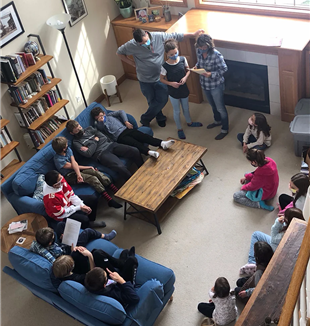
He Was Happy Because He Knew He Was Loved
Minnesota students explore the world through the life of Blessed Hermann the Cripple.“Even though I was in quarantine, I felt like I was exploring the world,” wrote eleven-year-old J, reflecting back on her experience participating in weekly videocalls with her friends during the spring lockdown. Back in April, Fr. José and Raffaella invited their Fraternity’s children from ages nine through eleven to partake in 45-minute Zoom calls exploring the life of Blessed Hermann of Reichenau. “They accompanied one another on a wonderful adventure,” explained Raffaella, “discovering that reality is always beautiful and unlocking the secret to happiness while befriending Blessed Hermann.”
Hermann lived in 11th-century Germany. Also known as Hermann the Cripple, he was born with severe physical disabilities, which prompted his parents to leave him in the hands of local Benedictine monks. In the monks’ care, Hermann was able to withstand his enormous and constant physical pain, his deformities, and his communicative struggles. But his life was in no way about survival. Thanks to the love that nurtured him, he performed intellectual feats out of reach to most, mastering Latin, Greek, and Arabic, studying mathematics, composing renowned hymns such as the Salve Regina and Alma Redemptoris Mater, and writing the Chronicon and a treatise on astrolabes.
Raffaella described how, “starting from [Hermann’s] story, the children tackled several questions, such as how a suffering person can be so happy and passionate about reality to learn multiple languages and math and love music and the stars, whether happiness is related to our circumstances, and, more broadly, who the saints are.” To help the children explore their questions, different guests were periodically invited to discuss aspects of Hermann’s life: a Benedictine monk, a professor of Medieval History, two musicians and composers, two astrophysicists, two healthcare professionals, and a medical researcher who published a study on Hermann’s life.
Through it all, said Raffaella, “It was never a project by adults for the children, but instead the protagonists were always the kids. This allowed them to become passionate about what they were doing, to understand the core of this experience, and to develop a friendship with each other and with us [adults].” Indeed, the children led prayers and discussions themselves, and each week they took turns introducing the speakers. They were sometimes asked to draw pictures or make videos, and they conducted interviews with healthcare workers. “They discovered that there is beauty in what they like, and that in beauty there is the mark of God.”
The work itself enthused the children, and for all of them it boiled down to the striking way in which Hermann was able to be happy because of his active relationship with God. “Hermann was always happy even if he was very sick. I have learned that he was happy because he knew he was loved. He communed with God,” one of the kids wrote. Another echoed, “What struck me the most about Hermann was that even though he was always in pain, he was happy. He knew Jesus was always with him.”
Through their newfound friendship with Hermann, the children’s own relationship with God concretized as well. As one of them expressed, “I learned that even if things are hard, I can always ask Hermann, God, Jesus, or Mary for help because even though Hermann was a cripple, he could do all those things, so maybe I can do them too.” It then became clear for them that, as Raffaella explained, “Happiness is the most important question that a human being has in life. Our happiness doesn’t depend on whether reality is perfect or as we want it, but instead we are happy when we are in communion; that is, when we think, see, and feel like another does. This is what Hermann did: he communed with God. This was his ‘secret’ to always being happy. Therefore, reality can be beautiful even in suffering as a way to dialogue with the Creator, our Father.”
The kids’ discovery of happiness in communion with God through their relationship with their friends radiated in their respective homes. Their parents expressed gratitude for their Fraternity as a place outside of immediate familial relations that holds their children’s “desire for the infinite at heart,” as one of the parents said. “The kids now speak of the fraternity as their fraternity. It is a place where they are being generated,” wrote another parent, while a third admitted that “Hermann has become a friend to me too.”
The work on Hermann is finished, but the kids’ eagerness to be together prompted the adults involved to launch a new proposal. This fall, they are exploring the life of Pier Giorgio Frassati, meeting monthly on Zoom and more regularly in small local groups, this time also opening the proposal up to their school friends. “It’s been an educational experience also for me,” concluded Raffaella, grateful for the opportunity of learning from the kids in her fraternity. “I am always challenged and moved by their authenticity, freedom, and simplicity in front of their desires and in front of reality. They’ve experienced that there is a place that accompanies their families where they can learn without being measured, and where they are loved for who they are. And in these months, they’ve made this place their own.